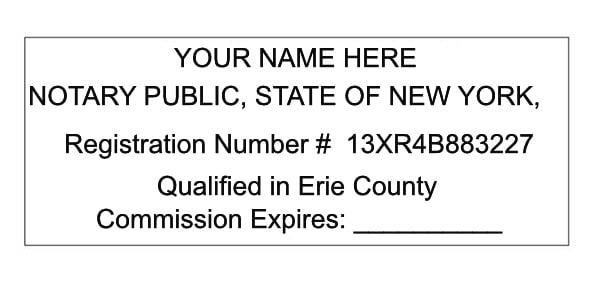-
Oct 23, 2024
-
Harrrison Carroll

The article below provides recommendations to what is on a New York Notary Stamp. A notary seal or notary stamp is one of the major elements of the notarization process, which validates the genuineness of signatures on a document. This stamp contains crucial information that identifies the authority and legitimacy of the notary public who performed the notarization. Here is a real sample of the information you would see on a notary stamp. For more information, visit the New York Department of State. It’s easy to locate where to have a document notarized. Banks, office supply stores, and many other places provide notarization.
Name of the Notary Public
The most obvious information on a notary seal is usually the name of the notary public. The notary public’s name identifies the individual authorized to perform notarizations and ensures that the parties are able to refer to the credentials of the notary. It is often written in an easy-to-read and readable font.
Title of Notary Public
Alongside the name, the surname “Notary Public” is added as a rule. This surname indicates the individual’s status and authority in the process of notarization. It is required to have this surname, as it distinguishes the notary from other experts and indicates that they have met their state or jurisdiction’s requirements.
State of Commission
Most notary stamps have the name of the state where the notary is commissioned. New York requires it. This is significant because notary law varies from state to state. Including the state helps authenticate the authority of the notary and renders the notarization legally effective in that state.
Commission Number
In New York, the notary stamp will also carry a commission number. This makes it a unique identifier assigned to the notary public upon acquiring their commission. It is yet another way of confirmation, which the concerned individual inspecting the document may use to verify the status and legitimacy of the notary with the concerned state agency.
Expiration Date
You must place the expiration date of the notary’s commission. This data is important. It shows the time period during which the notary is empowered to conduct notarizations. If the commission has lapsed, any notarizations executed subsequent to this date could possibly be invalid. A tip is below. When purchasing a stamp, leave the date of expiration blank. Then, when notarizing, complete it in black ink by hand. This way, you will not have to buy a new stamp every 4 years, when renewing you commission We have a blog entry on this Notary Stamp Tip.
Additional Information on The New York Notary Stamp
Substantive state law, there is other information on some notary stamps, such as the notary’s county of commission or special marks confirming the notary’s compliance with specific standards. This varies state by state and is not uniform. In New York, your stamp must note the county of your commission.
Usage in Documents
Once a document is stamped by a notary stamp, the document becomes properly notarized. Having the stamp provides a guarantee of protection against forgery, assuring that signers are actually who they purport to be and that the signatures on the document are legitimate. We are educating people about how to be a New York Notary at Notary New York.
Conclusion
Briefly put, a notary stamp is just not just a mere pen imprint on paper; it represents essential information affirming the credibility of notarized transactions. A New York Notary Stamp needs to display accurate information on it. After inserting details such as the notary’s name, title, commission state, commission number, and expiration date, the stamp serves as an effective legal attestation tool as well as an anticounterfeit guardian. It is crucial to know what constitutes a notary stamp to anyone involved in the process of notarization as it highlights the importance of these formalities in validating documents. We hope these findings provide the needed information regarding the New York Notary Stamp.
Violations of these guidelines would place a notary in risk of liability. We have an article in our blog discussing the notary’s liability, to which you are encouraged to review.
Comments are closed.